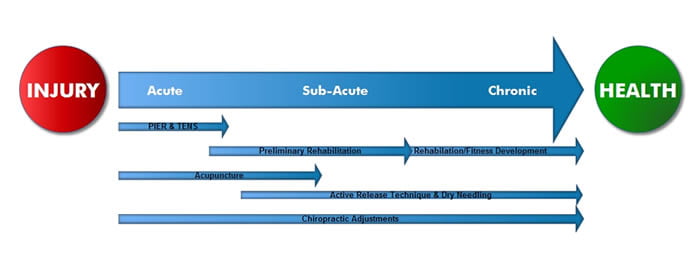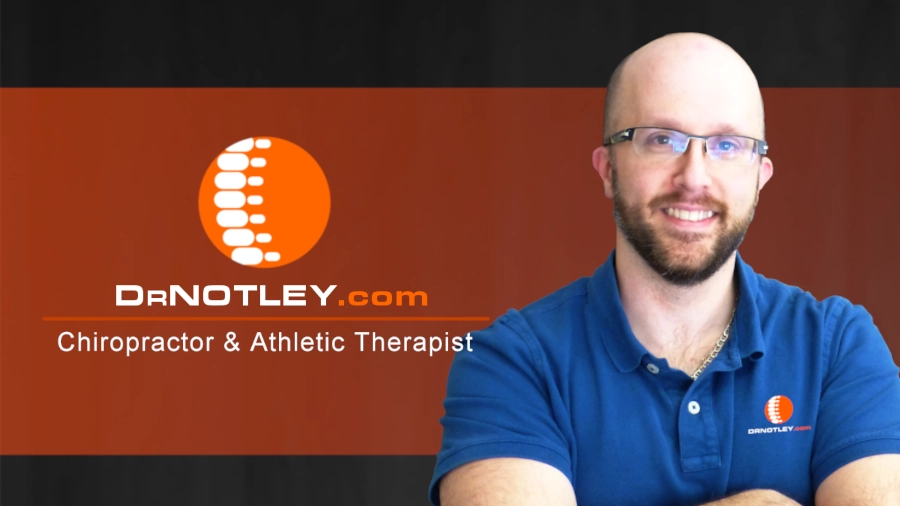So you are dealing with an injury. It is a frustrating time being in pain and not being able to do the activities you love doing. You may be planning on seeing someone for this injury and you are wondering, “What type of care should I expect to receive?” The answer to this question depends on how long you have been injured before you seek out care and who you are going to go see. There are typically 3 phases of care; acute, sub-acute and chronic phases. What you should expect during your injury rehabilitation depends on the signs and symptoms that you are experiencing which are associated with the length of time since the injury occurred.

Acute Phase Injury Rehabilitation– Days 1 to 3
What are you experiencing?
In the acute phase, you experience pain, inflammation, warmth, swelling, and reduced range of motion and strength.
What type of treatment?
The goals during this phase are to reduce pain and manage inflammation. Minimizing aggravation can accelerate recovery. More recently treatment has shifted from following the PIER or RICE principles to following the PEACE principles. During this face you want to protect the area, elevate the area (depends on what is injuries), minimize the use modalities that reduce inflammation, compress the region and being educated on what to expect for recovery. Ice, TENS, acupuncture, and chiropractic adjustments may be used for pain reduction along.
Sub-acute Phase Injury Rehabilitation – Day 3 to 3 Months
What are you experiencing?
In the sub-acute phase, active inflammation is likely subsiding, though some residual inflammation may persist. Scar tissue begins to form, but proper care during the acute phase can minimize this. You might notice adhesions between muscles, nerves, and ligaments, along with muscle tightness and trigger points. Pain decreases, and range of motion and strength start improving.
What type of treatment?
The goal in this phase of injury rehabilitation is continue to manage pain, improve range of motion, begin strengthening injured tissues, and limit adhesions. Acupuncture and dry needling may help with pain relief, while ice or heat can help reduce pain and manage residual inflammation. Active release techniques and fascial manipulation can help stretch tight muscles, reducing trigger point tenderness, and desensitize tender tissues. Chiropractic care (joint mobilizations, adjustments or manipulation) helps improve joint range of motion and reduces pain. Remedial rehabilitation exercises, including range of motion and strengthening exercises, are incorporated and progressed during this phase.
Ideally, we want to see you back living your life despite the injury, It’s crucial to continue working and moving as long as it doesn’t aggravate your symptoms. Your work may have to make accommodations so you can continue to work. This may include changing activities to lighter duties, different workstation set up, reduced work hours, the freedom to change activities as needed, etc.
This is the phase where most people disappear from care. Their pain is beginning to be more manageable and they feel they can do it on their own. Sadly this is the most crucial time not to stop care. Jumping back into the activities that once caused the injury may flare ups or a reinjury. Reduced pain doesn’t mean the body is prepared to go back to regular life just yet.
Chronic Phase Injury Rehabilitation – 3 Weeks and Onward
The chronic phase can present in two distinct ways, depending on whether you’ve consistently managed the injury or are just beginning to seek care.
Chronic Phase – Type I
What are you experiencing?
In the ideal chronic phase, you’ve received consistent treatment since the injury’s onset. Pain is minimal, surfacing only during activities that stress the injured area. Although pain is under control, this phase is not the time to cease treatment. Many people stop care prematurely, risking re-injury because their bodies haven’t yet developed the necessary strength and flexibility.
What treatment should you expect?
Continuing with techniques like active release techniques, chiropractic care, and dry needling for residual problem areas is essential. Focus shifts to developing strength, flexibility, balance, and stability to prevent further injuries. The intent is to improve capacity of the injured area to handle more stress. This phase is critical for ensuring long-term recovery, as tissue takes about a year to fully develop and strengthen.
Chronic Phase – Type II
What are you experiencing?
This phase is common among those who have neglected their injury for over three months, often extending to years. Repeated small traumas and chronic movement habits along with health and psychosocial components can contribute to persistent pain, reduced range of motion, and reduce capacity to work or exercise.
What type of treatment should you expect?
Initial treatment mirrors the sub-acute phase, using dry needling, active release techniques, and chiropractic care to reduce pain and improve range of motion. As pain subsides, a rehabilitation program will focus on strengthening weak muscles and stretching tight ones. Postural exercises and ergonomic changes in your daily environment are crucial. If there are health issues or psychosocial issues these should also be addressed by the appropriate professional
Wellness Phase – Enhanced Life Beyond Injury
This phase represents the ultimate goal: enhancing your life beyond injury. Pain is minimal or non-existent, your body is strong and your tight muscles are flexible. Your rehabilitation program evolves from injury care to health enhancement, allowing you to stay active without pain. Improved dietary choices support overall health. Treatments become less frequent as you learn to manage pain independently, with occasional “tune-ups” as needed.
Conclusion
Effective injury care requires a multi-faceted approach, as no single treatment is universally superior. Each has its benefits when used appropriately. Stay proactive in your care and don’t hesitate to ask questions.
Originally posted on May 17, 2022 @ 4:37 pm
